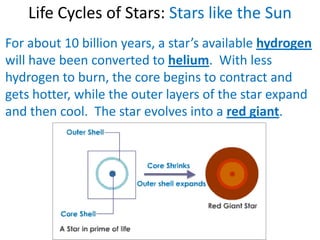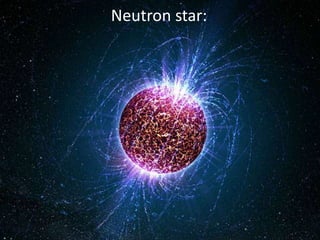07 stars, constellations, and asterisms
- 2. Stars, Asterisms, and Constellations
- 3. Stars A star is a massive, luminous sphere of plasma held together by gravity. Ex: the sun is a star
- 4. Life Cycles of Stars Every star has a life cycle: a beginning, a middle and an end. At the beginning, a star forms from a massive cloud of gases and dust called a nebula (gases include hydrogen and helium).
- 5. Life Cycles of Stars The gravitational forces begin to pull the gas and dust particles close together, creating clumps. The clumps become more massive and gravity becomes even stronger. Over time, a dense region forms, called the protostar.
- 6. Life Cycles of Stars Gravity causes the core of the protostar to become very tightly packed and the pressure causes nuclear fusion to begin. Hydrogen atoms in the core fuse to make helium atoms and as a consequence, produce tremendous amounts of energy.
- 7. Life Cycles of Stars Billions of years after forming, the star begins to burn out.
- 8. Life Cycles of Stars: Stars like the Sun For about 10 billion years, a star’s available hydrogen will have been converted to helium. With less hydrogen to burn, the core begins to contract and gets hotter, while the outer layers of the star expand and then cool. The star evolves into a red giant.
- 9. Life Cycles of Stars: Stars like the Sun
- 10. Life Cycles of Stars: Stars like the Sun Our sun will become a red giant in 5 billion years. The outer layers of the star expand sharply, pouring solar matter into space. This leaves a small, dim hot core behind – a white dwarf.
- 11. Life Cycles of Stars: Stars like the Sun As the sun’s mass reduces, the planets will not be attracted to the Sun as strongly as at present and their orbits around the Sun will shift further outwards. The Earth will gradually move to where the planet Mars orbits today.
- 12. Life Cycles of Stars: Stars like the Sun
- 13. Life Cycles of Stars: Stars like the Sun
- 15. More massive stars Stars that are more massive than our Sun (i.e. 10 times more larger) will become a red supergiant. Once fusion stops, the supergiant will have its contents collapse on its self under its own gravity. The outer layers of the star explode outwards – known as a supernova.
- 16. Supernova All the atoms we are made from came originally from these giant supernova explosions.
- 17. If a star’s initial mass was: • between 10 and 30 solar masses a neutron star is formed – an extremely dense star composed of tightly packed neutrons. • greater than 30 solar masses black hole is formed – a quantity of matter so dense and gravity so strong that not even light can escape.
- 18. Neutron star:
- 19. Neutron star:
- 20. Neutron star:
- 21. Black hole:
- 22. Black hole: Simulation of gravitational lensing by a black hole, which distorts the image of a galaxy in the background
- 23. Summary
- 25. Asterisms and Constellations Constellation: a group of stars that seem to form a distinctive pattern in the sky. There are 88 officially recognized constellations
- 26. Asterisms and Constellations Asterisms: smaller groups of stars that form patterns within a constellation i.e. the Big Dipper (an asterism) is part of the constellation Ursa Major
- 32. Constellations The constellations you can see depend on your latitude as well as the time of night and time of year The images below show the North Sky viewed in the: Spring vs Winter
- 33. Spring
- 34. Winter
Editor's Notes
- http://www.youtube.com/watch?v=a19fhhJcs1E (life cycle of a star – 44 minutes)
- http://www.youtube.com/watch?v=a19fhhJcs1E (life cycle of a star – 44 minutes)
- http://www.youtube.com/watch?v=TOn7MNA_A1k (death of SN 2006gy)
- http://www.youtube.com/watch?v=yqWNyR56jxo (black holes)
- http://www.youtube.com/watch?v=a19fhhJcs1E (life cycle of a star – 44 minutes)

































